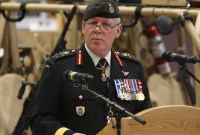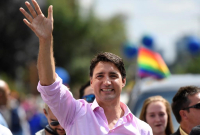Support strong Canadian climate journalism for 2025
The man who leads the Canadian Armed Forces says military leaders have failed to grasp the importance of recruiting more women and minorities, partly because they have for too long relied on an antiquated template for recruits.
Gen. Jonathan Vance, the chief of defence staff, told a defence and security conference Saturday that the military has to change because the very nature of warfare is changing, particularly when it comes to cyber-warfare.
"I think we ... stand accused of looking backwards and seeing what worked in the past and keeping (those practices) going forward," Vance told the Halifax Security Forum, which has attracted more than 300 experts, politicians and military officials from around the world.
"That worked through a great stretch of warfare that was state-on-state, that matched physical versus physical. All of us in this room are infused with that DNA."
He said the problem is that the nature of warfare is changing — fast.
"It has required that we become diverse so that we attract the talent (we need)," he told a panel discussion. "We know that the future of warfare is going to demand different ways of thinking in different domains so that we can prevail."
He said the template the military uses to find ideal recruits, which is largely based on physical attributes, must be altered for certain jobs.
"We've created a template, and inside that template is the perfect military recruit ... and everybody else who is not in that template, the antibodies start to gather around them," he said.
"We've gone through that with LGBTQ2 (people). We've gone through that with race. We've gone through that with women."
Janet Wolfenbarger, a retired general who served in the U.S. Air Force for 35 years, said the American military has made great strides when it comes to gender equity, but she made it clear it still had a long way to go.
While she served in the air force, Wolfenbarger said the proportion of women in uniform rose from 10 per cent in the late 1970's to about 19 per cent in 2015 when she retired.
Wolfenbarger was promoted to be the first female four-star general in the U.S. Air Force in 2012, and there are now six women in the U.S. military at that level.
"I maintain that the glass ceiling has been broken," she said. "That has opened up opportunities for women to look up and see there are opportunities ... but there is still work to be done."
Jacqueline O'Neil, a global fellow at the Woodrow Wilson Center's Canada Institute in Washington, D.C., said Canada's adversaries have already opened their doors to diversity.
She said Islamic State militants use highly customized recruitment videos aimed at women, which is partly why one in five foreign fighters who leave Europe to fight for the group are female.
"They are targeting them online ... and they are using women to recruit other women," O'Neil told delegates.
O'Neil said about two thirds of the suicide bombers used by the Islamic State in West Africa, commonly known as Boko Haram, are women.
"They understand that women generate less suspicion in public spaces, are less likely to be searched ... and they have exploited that."





Comments